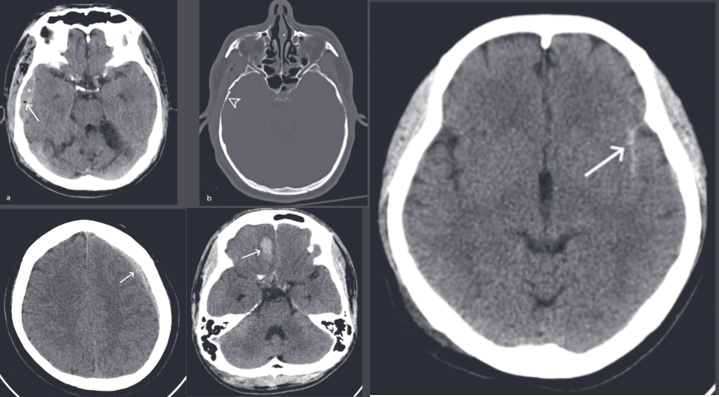Clinical Association Factors for Abnormal Cranial CT Scan in Moderate-Risk Patients of Mild Traumatic Brain Injury
Keywords:
Clinical factor, Abnormal cranial CT scan, Mild traumatic brain injury, Moderate riskAbstract
Introduction: Moderate-risk patients with mild traumatic brain injury have not needed routine cranial CT scans. The management can be observed after presentation or undergoing a cranial CT scan. A cranial CT scan in this group is warranted in selected cases. This study aims to find clinical association factors for abnormal cranial CT scan in moderate-risk patients of mild traumatic brain injury for identifying the patients who may need a cranial CT scan to reduce unnecessary cranial CT scans and the cost of treatment.
Objective: This study’s purpose is to evaluate clinical association factors for abnormal cranial CT scan in moderate-risk patients of mild traumatic brain injury.
Methods: Data of moderate-risk patients with mild traumatic brain injury of Thammasat University Hospital with age ≥ 18 years and ≤ 64 years who underwent a cranial CT scan within the first 24 hours after the onset of the injury were collected. Multivariable logistic regression was used to determine positive CTs’ adjusted odds ratio (OR).
Results: Of all 225 patients, 134 (59.6%) had negative cranial CT findings, and 91 (40.4%) had positive cranial CT findings. There were three independent clinical presentations associated with abnormal cranial CT findings including GCS, vomiting and post-traumatic amnesia, the adjusted OR (95% CI) of which were 2.32 (1.04-5.20) (P-value = .040), 4.86 (1.04-22.69) (P-value = .045) and 2.30 (1.12-4.35) (P-value = .010), respectively.
Conclusions: Clinical association factors for abnormal cranial CT scan in moderate-risk patients of mild
traumatic brain injury, including GCS lower than 15, vomiting, and post-traumatic amnesia.
Downloads
References
Phuenpathom N, Srikijvilaikul T. Clinical Practice Guidelines for Traumatic Brain Injury. 1st ed. Bangkok: Prosperous Plus; 2019.
Thairsc. Road Accident Victims Protection Company Limited. http://www.thairsc.com/. Published 2021. Accessed October 17, 2021.
Levin HS, Narayan RK, Wilberger JE, Povlishock JT. Outcome from mild head injury in Neurotrauma. New York, NY: McGrawHill; 1996.
Haydel MJ, Preston CA, Mills TJ, Luber S, Blaudeau E, DeBlieux PMC. Indications for computed tomography in patients with minor
head injury. N Engl J Med. 2000;343:100-105.
Stiell IG, Clement CM, Rowe BH, et al. Comparison of the Canadian CT head rule and the New Orleans criteria in patients with minor head injury. JAMA. 2005;294:1511-1518.
Haydel MJ. Clinical decision instruments for CT scanning in minor head injury. JAMA. 2005;294:1551-1553.
Goergen S, Varma D, Tavender E, et al. Adult head trauma, education modules for appropriate imaging referrals. Royal Australian and New Zealand College of Radiologists. 2015:1-32.
Mack LR, Chan SB, Silva JC, Hogan TM. The use of head computed tomography in elderly patients sustaining minor head trauma. J Emerg Med. 2003;24:157-162.
American College of Surgeons. Advanced Trauma Life Support® Student Course Manual. 10th edition. Chicago: American College of
Surgeons; 2018.
Geifman N, Cohen R, Rubin E. Redefining meaningful age groups in the context of disease. AGE. 2013;35:2357-2366.
Srichaikul P. The prevalence and factors related to abnormal brain lesions in the mild traumatic brain injuries of patients admitted to the emergency room of Banglamung hospital. J Prapokklao Hosp Clin Med Educat Center. 2018;35:363-371.
Sharif-Alhoseini M, Khodadadi H, Chardoli M, Rahimi-Movaghar V. Indications for brain computed tomography scan after minor head injury. J Emerg Trauma Shock. 2011;4:472-476. 13. Mishra RK, Munivenkatappa A, Prathyusha V, Shukla DP, Devi BI. Clinical predictors of abnormal head computed tomography scan in patients who are conscious after head injury. J Neurosci Rural Pract. 2017;8:64-67.
Yuksen C, Sittichanbuncha Y, Patumanond J, et al. Clinical factors predictive for intracranial hemorrhage in mild head injury. Hindawi Neurology Research International. 2017:1-5.
Molaei-Langroudi R, Alizadeh A, Kazemnejad-Leili E, Monsef-Kasmaie V, Moshirian S. Evaluation of clinical criteria for performing brain CT-Scan in patients with mild traumatic brain injury. Bull Emerg Trauma. 2019;7:269-277.
Limsuriyakan W, Lorwanich P. Factors associated with intracranial hemorrhage in mild traumatic brain injury moderated risk patients at Phra Nakhon Si Ayutthaya Hospital. TUH Journal online. 2019;4:1-10.
Rafay M, Hussain F, Gulzar F, Ain N, Sharif S. Vomiting in mild head injury, an indicator for CT scan. Surgery Curr Res. 2019;9:331.
Seddighi AS, Motiei-Langroudi R, Sadeghian H, et al. Factors predicting early deterioration in mild brain trauma: A prospective study.
Brain Inj. 2013;27:1666-1670.

Downloads
Published
How to Cite
Issue
Section
License
Copyright (c) 2022 Asian Medical Journal and Alternative Medicine

This work is licensed under a Creative Commons Attribution-NonCommercial-NoDerivatives 4.0 International License.


